Chiang Mai will never not feel like home to me.
Every time I touch down at the airport, I feel my stresses start to drift away. Once I’ve piled myself into a songthaew and begun making my way into the city, my heart begins to race. And when I set my sights on the city’s moat once more? Even if it’s the fiftieth time I’ve done so, I still break out in a smile.
Chiang Mai.
Welcome to one of the best cities in Southeast Asia — and my home away from home. I’ve now spent over a year of my life living and loving (and eating) in Chiang Mai. I met my partner of 12 years in this very city, in fact, and even built this website while I was there, too.
I confess it’s not a particularly unique story within the digital nomad community anymore — we all have a habit of spending an extended amount of time in this town — but that doesn’t make it any less special to me: Chiang Mai was where it all began. Trust me, this city has a habit of changing people’s lives.
Now, while many online workers choose to call this city home, it has just as much to offer to its visiting tourists. There’s so much to do here! You’ve got dozens of gleaming gold wats to wander around, exceptionally tasty street food, beautiful coffee shops, excellent shopping, and — as I mentioned above — a moat that encircles its old town. And the day trips? I recommend taking at least one of them.
I’ve always enjoyed having friends and family come out to visit me in Chiang Mai, and I’ve subsequently spent weeks of my life showing them around the city I know best. Now, I’m going to hopefully do the same for you. So grab a cold can of Singha beer and get ready for a long read.
These are the best things to do in Chiang Mai.
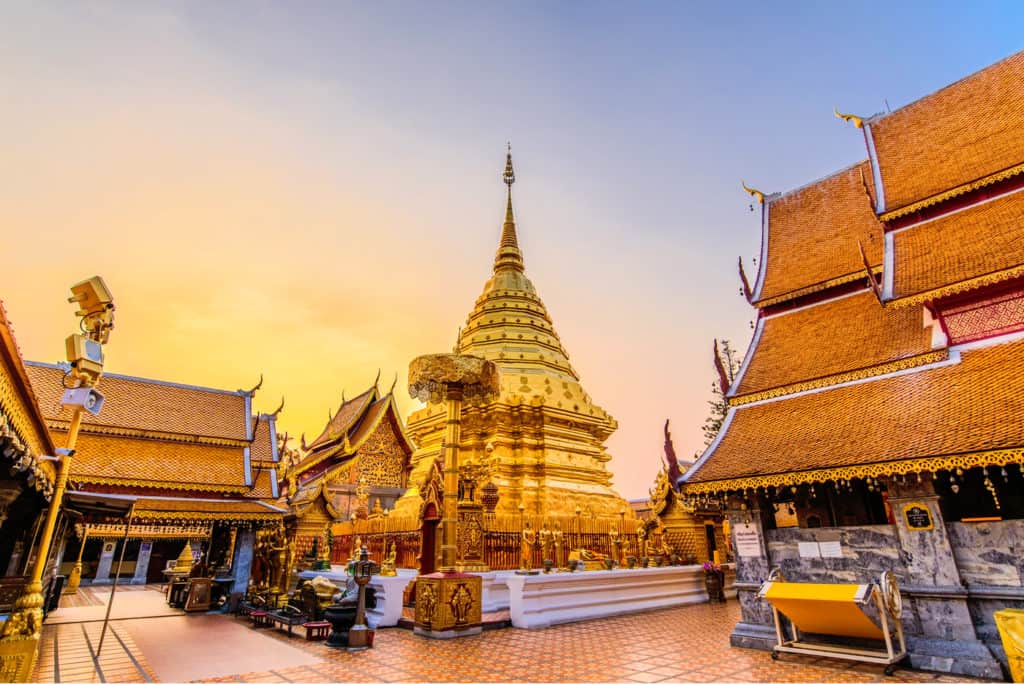
Explore Wat Phra That Doi Suthep
As you travel north to Chiang Mai, the landscape quickly changes and the mountain air streaming into the valley can bring some crisper evenings. Up in those hills you’ll find the beautiful summit temple of Wat Phra That Doi Suthep, whose central structure contains the renowned seated Buddha.
It’s one of the most popular destinations in Chiang Mai and there are several options for travelers looking to visit the sacred grounds. Many choose to ride their own scooter up into the mountains, or jump into the back of a songthaew, a local taxi. However, to earn the summit, the gorgeous temples and picturesque vistas, why not hike to the top?
The sweat-inducing adventure will add another memorable layer to this experience, leading you to the bottom of a sharp staircase. From there, wander by two demonic statues, up into the embellished temple. Wander through the small museum, by Buddha statues and elephant carvings, before admiring the views of Chiang Mai in the valley below.
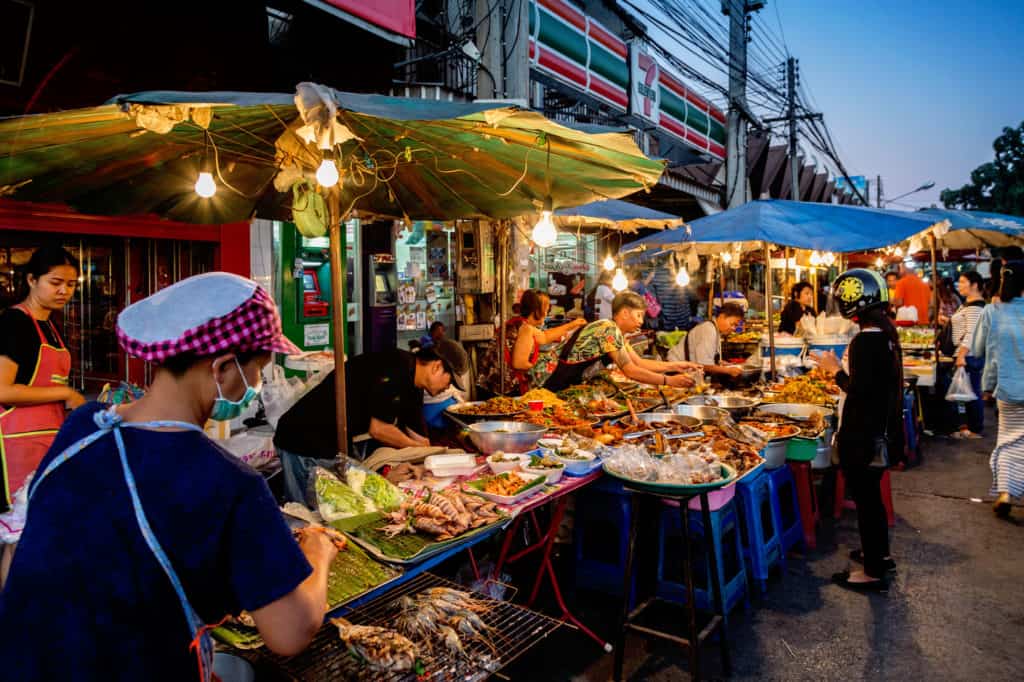
Mingle with Locals at Chiang Mai Gate Market
A major reason Chiang Mai has quickly become a beloved destination for travelers is the local culture. The slower paced community, with its historic moat and a backdrop of mountains, is easy to assimilate into. Aside from exploring temples, a wonderful way to experience local life is to wander down to the Chiang Mai Gate Market.
Home to some of the most delicious street food, not just in the city but all of Thailand, you can have your pick of authentic food every night of the week. The rule of thumb for good street food in Thailand is the length of the line and the number of locals. This market passes the test and is most busy during the working week compared to the weekend.
If you’ve been reluctant to dive into the street food scene, you don’t have to begin with deep fried crickets. Start easy with fried noodles and skewers before ending with a delicious dessert of sticky rice and mango.
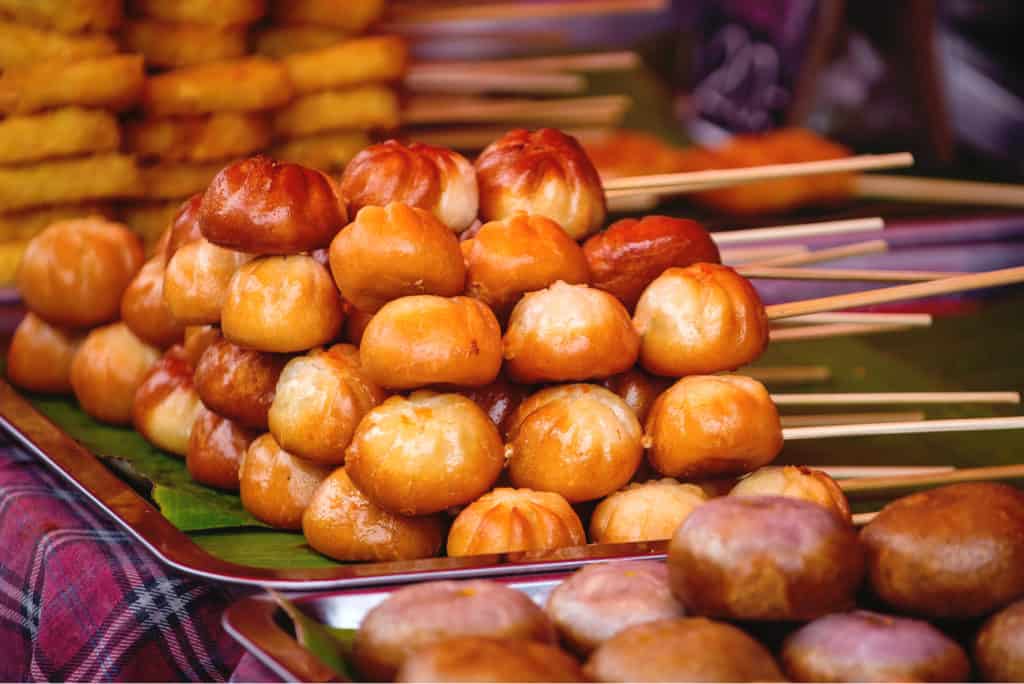
Take a Food Tour
One of the best ways to learn about a culture while also having a thrilling time is on a local food tour. Thai cuisine is world-renowned, but those familiar with it may be surprised by the distinct differences between authentic northern cuisine and that found in southern parts of Thailand, such as Bangkok and Phuket.
Some of the local dishes include the famous khao soi. The coconut curry is infused with Burmese influence and its crunchy noodles add a delightful twist to the meal. Others include fried laab, which is minced meat rubbed in a variety of local spices before being cooked over an open grill. Another must-try dish is nam ngiao, a zesty tomato soup with diced pork. Along the way, you’ll spot plenty of national favorites, including Pad Thai and other vegetarian dishes.
On this street food market tour, you’ll sample eight traditional dishes from Chiang Mai, while exploring the exciting night markets that are found throughout the city.
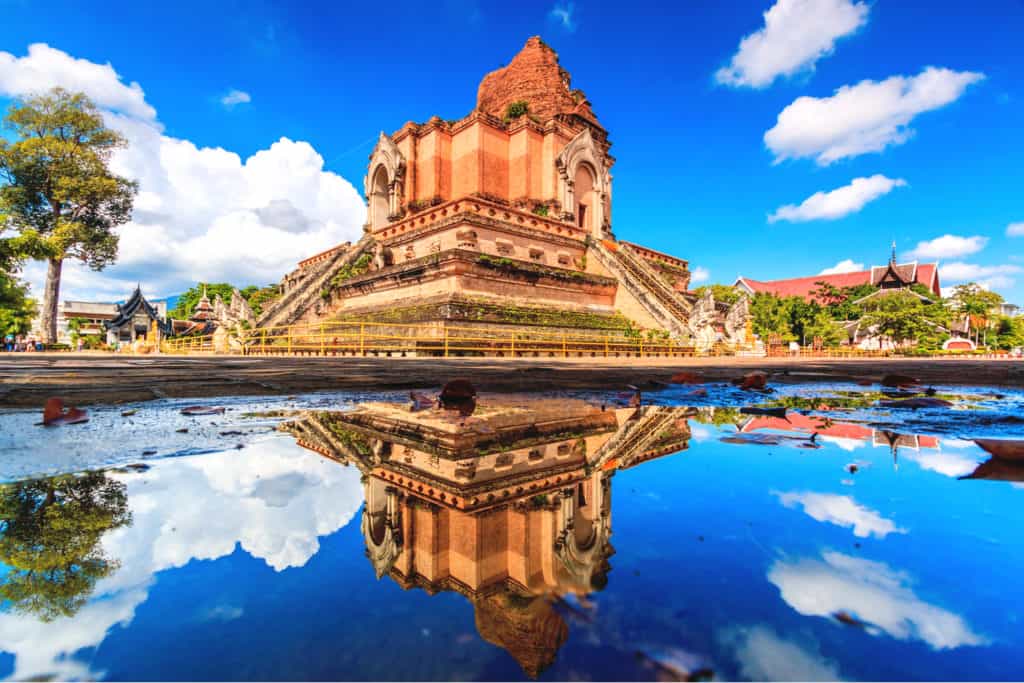
Explore the Ruins at Wat Chedi Luang
By now you’d know, temples aren’t a rare sight in Chiang Mai. But Wat Chedi Luang is a unique site, home to a historic temple that was constructed at the beginning of the 15th century. With much of it laying in ruin, it’s evocative, somewhat haunting and creates a beautiful contrast with the perfectly gilded temples around Chiang Mai.
After opening in 1401, Wat Chedi Luang suffered irreparable damage only 145 years later. Today, you can see it as it has been since the 16th century with its incredible elephant carvings still as clear as day. But this temple isn’t the only one here. You’ll also have the chance to visit Lak Muang. Constructed recently in 1940, Lak Muang replaced a wooden shrine and stands alongside a giant gum tree. Tradition states that if the gum tree falls, so will Chiang Mai.
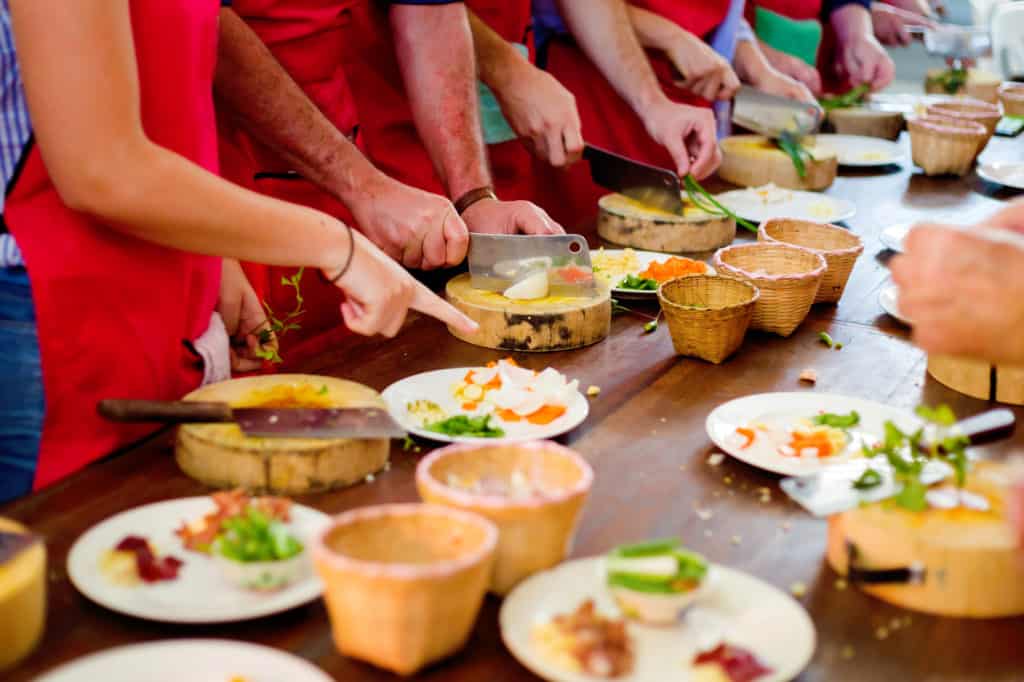
Join a Cooking Class
While your tastebuds won’t soon forget the explosion of flavor on your food tour, one way to bring a taste of Chiang Mai home with you is by joining a local cooking class. Where you’ll learn how to master the delicate balance of the saltiness, spice and sweetness that encapsulates Thai cuisine.
There is an abundance of cooking classes in Chiang Mai, all of which have their own selling point. Whether that be more dishes, a market tour, or organic ingredients. You’ll be able to find one that suits your personality to a tee.
The good news is that even newbie chefs can pick up the skills of the local cuisine. Thai cuisine is simple and convenient. With the help of dried spices commonly found in Lanna cuisine, you’ll be an expert in no time.
My favorite Chiang Mai cooking class begins with a visit to a local farm. Prepare your curry paste from scratch before creating five authentic dishes.
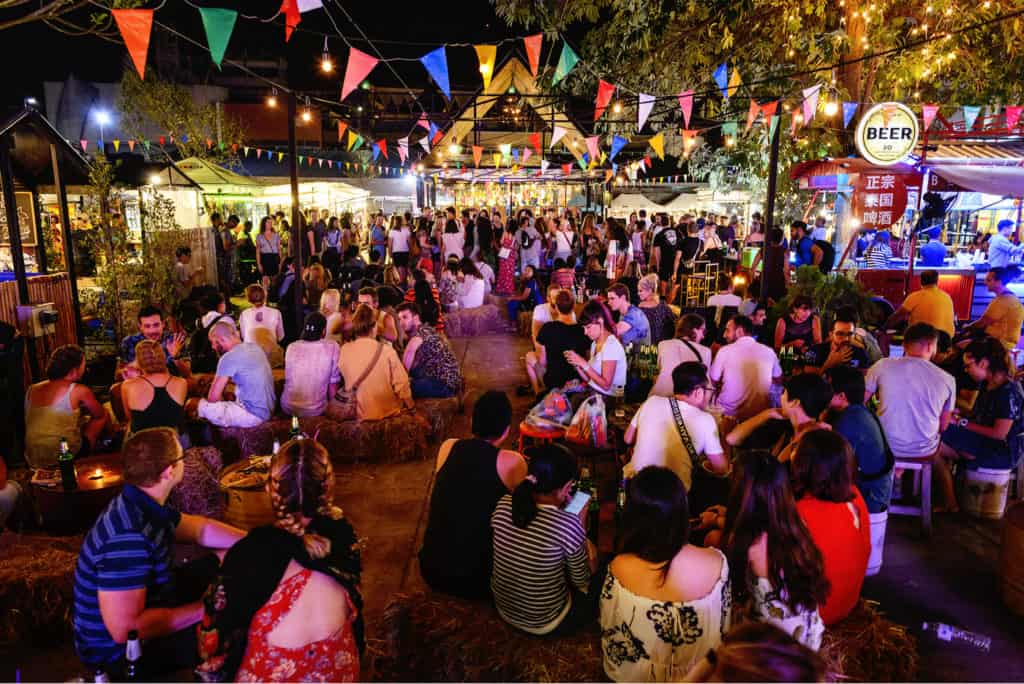
Wander Through the Night Bazaar
With a few adventures outside the boundaries of Chiang Mai, dive right back into the action at the Night Bazaar. A captivating atmosphere sweeps through the bazaar nightly at 6pm when vendors arrive to restock and prepare for the night ahead. Although they get a head start, so arrive an hour later when things truly kick off.
The Night Bazaar is an open-air market that runs down much of Rachadamnoen, the Old Town’s main street. Such is the popularity of the market that surrounding traffic is blocked off and nearby streets have their own stalls to get in on the fun. Stalls are set up on the paths and in the center of the road, creating endless options as you wander along.
Unsurprisingly, there isn’t much you won’t find here. From clothing and trinkets to beautiful artwork and artisan goods. The street food here also happens to be top notch. Once you’ve seen it all, pop into the local boxing stadium for a Muay Thai experience.
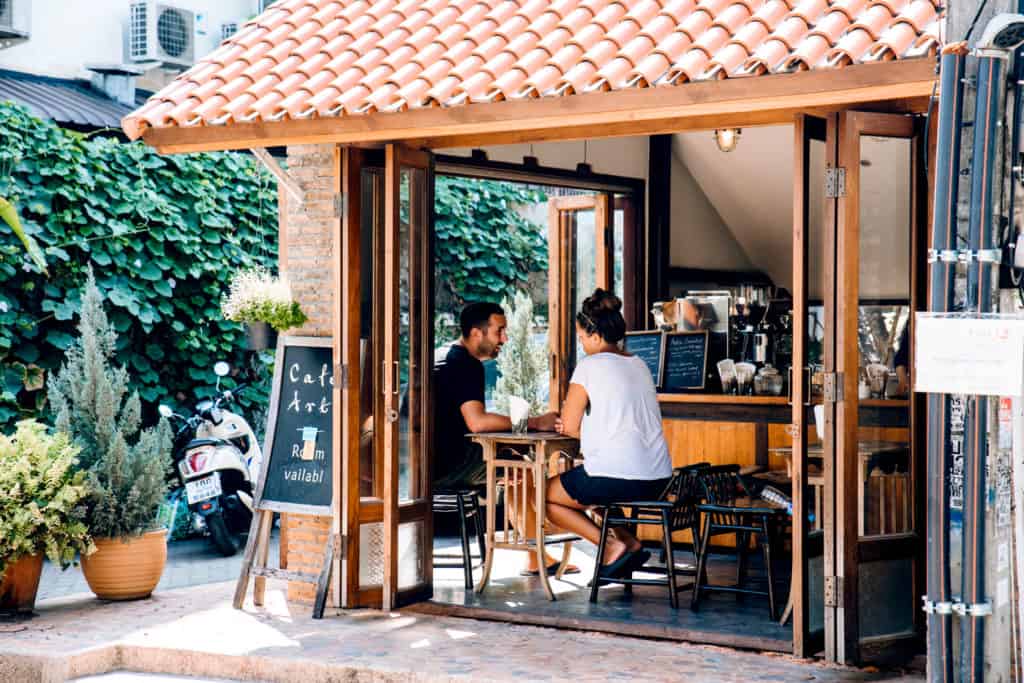
Drink the Local Coffee
Thailand has a developing coffee scene that’s ever so slowly catching up with those found in Indonesia and the neighboring country of Vietnam. The best example of its burgeoning coffee culture can be found in Chiang Mai. With a bit of help from local expats, the northern city now has a number of quirky and interesting cafes that make for the perfect morning wake up or afternoon rejuvenation.
Although Chiang Mai can be less hectic than other regions in Thailand, its many adventures will require plenty of energy. Thankfully, you’ll have plenty of options for a pick-me-up. Better yet, digital nomads will have a buffet of of cozy cafes with fast WiFi.
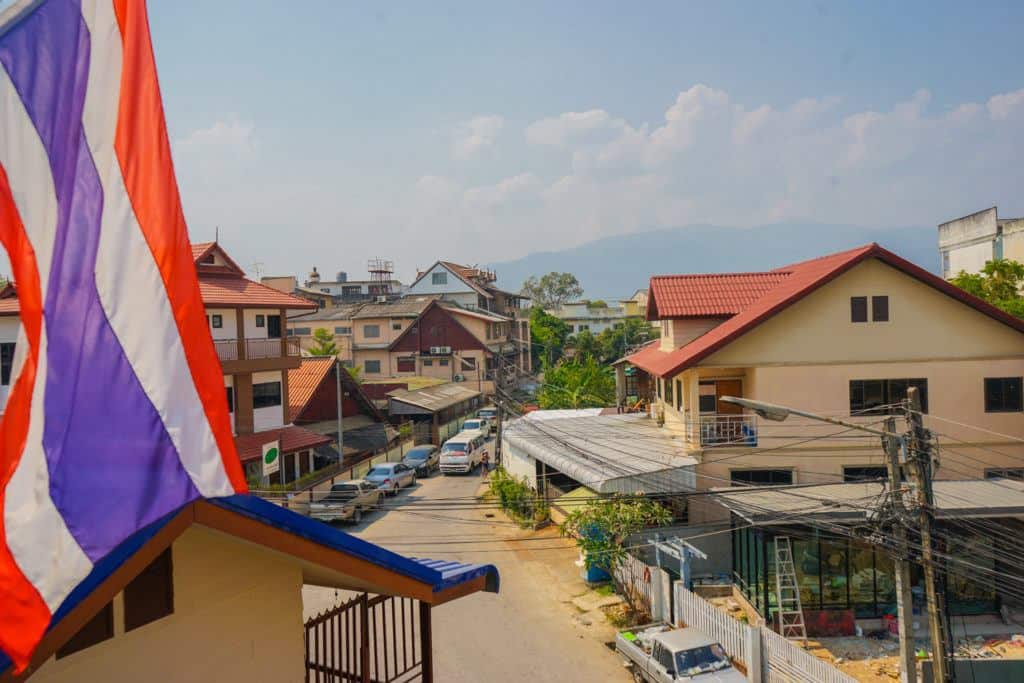
Walk through the Old Town
For centuries, all that existed in Chiang Mai could be found within the walls and moat that now surround the Old City. It’s within this space that you can find some of the original temples, and some of the best museums and galleries in Chiang Mai. With the cultural experience beginning at your doorstep, it’s no surprise many travelers choose to stay right here.
With the rest of the city home to most residents and daily activity, life in the Old City tends to be quieter, with much less traffic. It’s a fun place to get about on foot, without a map or plan, letting your instincts guide you along the way.
Some of the top attractions in the Old City include the Chiang Mai National Museum and the Arts and Culture Centre. You’ll find no shortage of temples here either, as it’s home to the historic Wat Chedi Luang and Wat Phra Singh.
See it all, plus some hidden gems on this 4-hour bike tour.
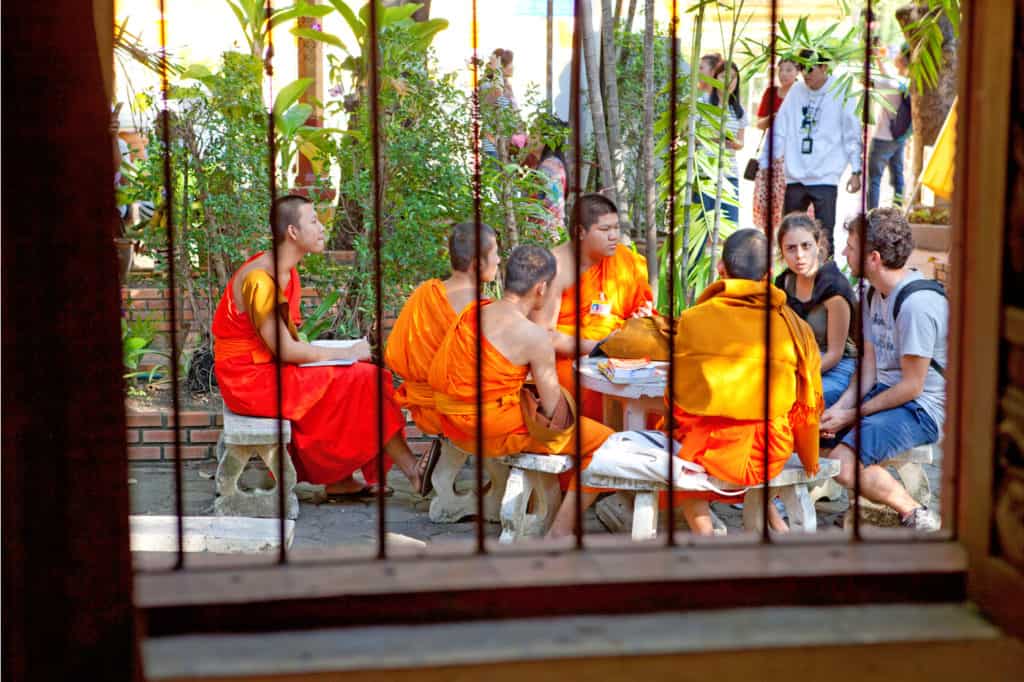
Chat With a Monk
Visiting the many temples in Chiang Mai can keep any traveler busy for days on end. Each enriching experience will help you gain more insight and appreciation not just for Buddhism, but local culture and the history of Chiang Mai. But what if I was to tell you that you can take this experience to another level?
Many of the “wats” have what’s simply called a Monk Chat program, which is exactly as it sounds. Within these select temples, monks will make themselves available to talk with travelers who can take a deep dive into spirituality and culture. The trade off being the monks can work on their English, often with a great deal of heart-warming enthusiasm,.
Some temples to visit for this enlightening experience include Wat Chedi Luang, Wat Suan Dok, and Wat Sisuphan. Many of these chats are then followed by voluntary meditative classes that are open to the public.
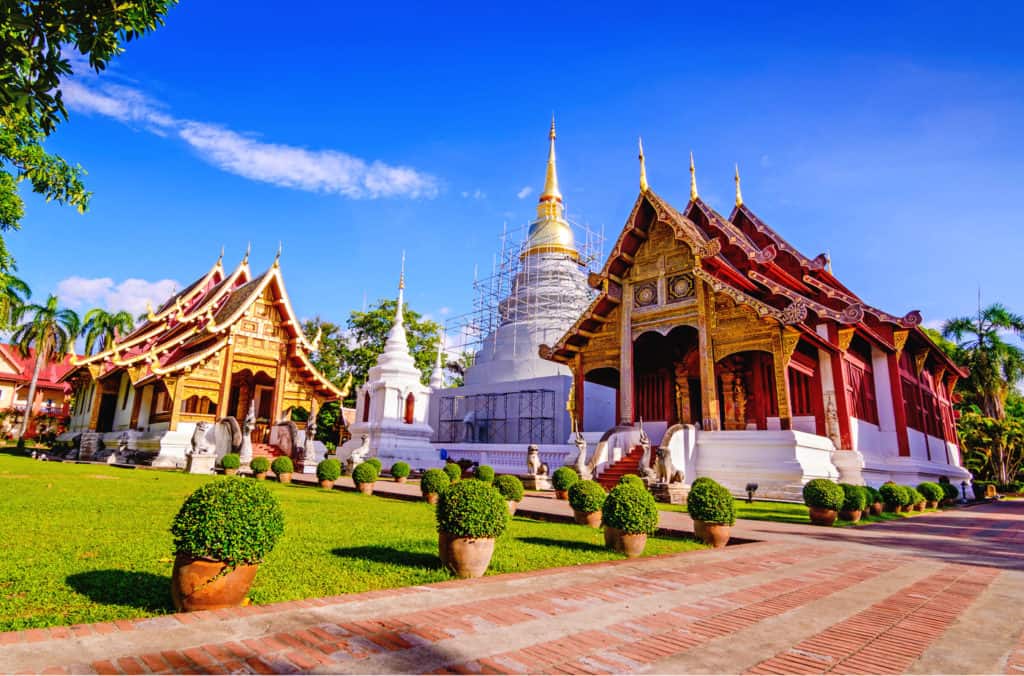
Pay a visit to Wat Phra Singh
On your adventures around the Old City, you’ll stumble upon one of Chiang Mai’s most celebrated temples. After Doi Suthep, Wat Phra Singh is the most revered in the region. While taxis may horde around the entrance hoping to pick up guests, once you’re inside, it becomes a tranquil experience.
The lavish designs are best exemplified by the mosaic-laden sanctuary, surrounded by manicured gardens and intricate carved designs. Aside from the exceptional interior work, the temple’s highlight is Phra Singh, aka the Lion Buddha, an image that has drawn pilgrims from all over Thailand, and indeed, the world.
It’s believed that Phra Singh arrived in Thailand having traveled from Sri Lanka in the 14th century. It’s now housed within a small chapel, Wihan Lai Kham, toward the back of the temple grounds. The interior of the chapel lives up to its revered status, with gilded designs and golden stenciling.
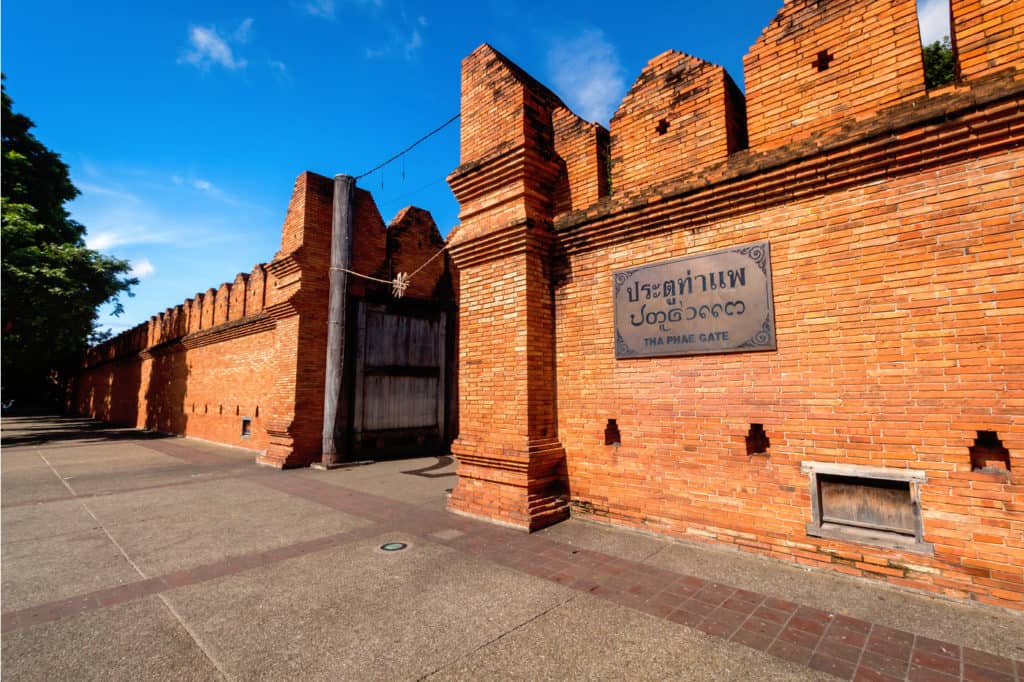
See Tha Pae Gate
As the gateway to the Old City, Tha Pae is one of the most iconic sites in Chiang Mai. The gate forms a part of the ancient city wall that was a fortress protecting the original inhabitants of Chiang Mai. While the wall may be slowly crumbling, the gate remains a popular spot for photography.
Through history, Tha Pae Gate welcomed traders, diplomats and monks from around Thailand. While much of the city has changed since the gate was built in 1296, the entryway remains largely the same. The gate faces due east and, like each gate in the Old City, it is aligned with astrology. It should come as no surprise that the gate has the faculty of Mula, otherwise known as prosperity.
Under the bright blue skies of northern Thailand, the red brick gate and enveloping wall create a beautiful contrast. Tha Pae Gate is also the host of several important festivals, including the Flower Festival and Loy Krathong. While each Saturday night, you’ll find live music in the square at the front of the historic gate.
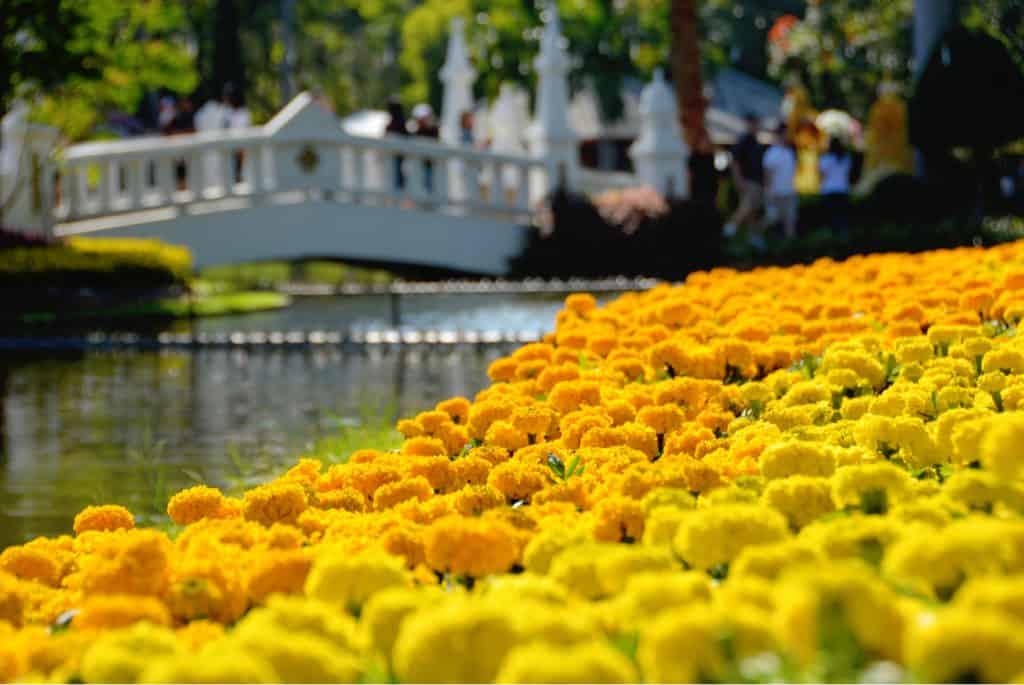
Picnic in Suan Buak Hat Park
There’s so many things to do in Chiang Mai that it can often feel like you’re rushing from one place to the next. For the opportunity to slow things down and hang with friends or read a book by yourself, head to the beautiful Suan Buak Hat Park.
In the Old City, the park is a quiet oasis, with lush grounds, small lakes and plenty of shade. It’s the perfect escape from your busy schedule, allowing you the time to reflect and simply enjoy the sights.
The park is a popular spot with locals who can often be seen doing a variety of morning exercises like tai chi and yoga, playing badminton or sitting by the lake. The park’s serene water feature also has a nearby coffee shop and basic snacks. Families can also make use of the playgrounds and large green spaces to run around.
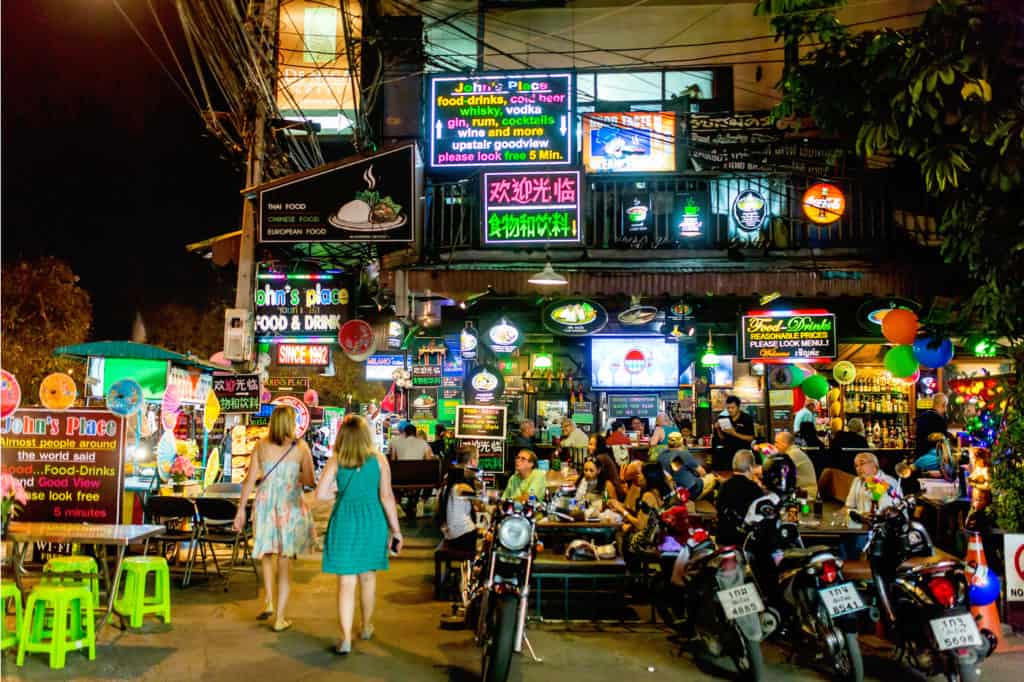
Enjoy the Nightlife
Chiang Mai doesn’t scream nightlife like other popular destinations in Thailand. In fact, a lot of people come here to escape that aspect of traveling in this country. However, you won’t find a shortage of bars and clubs if you’re still up for some fun after dark.
Around Chiang Mai, you’ll find a number of popular establishments that are a hit with locals and expats alike. Going out here can be as casual or as thrilling as you like, and it promises to be less “on the nose” than Bangkok, Pattaya, and Phuket.
Along the Ping River, you can join locals in having a chill evening by the water, enjoy a refreshing beverage with live music tunes floating through the air. For something more lively, head to the hotspot of Nimman Road, where you’ll find backpacker bars and chic hangouts, including the Monkey Club.
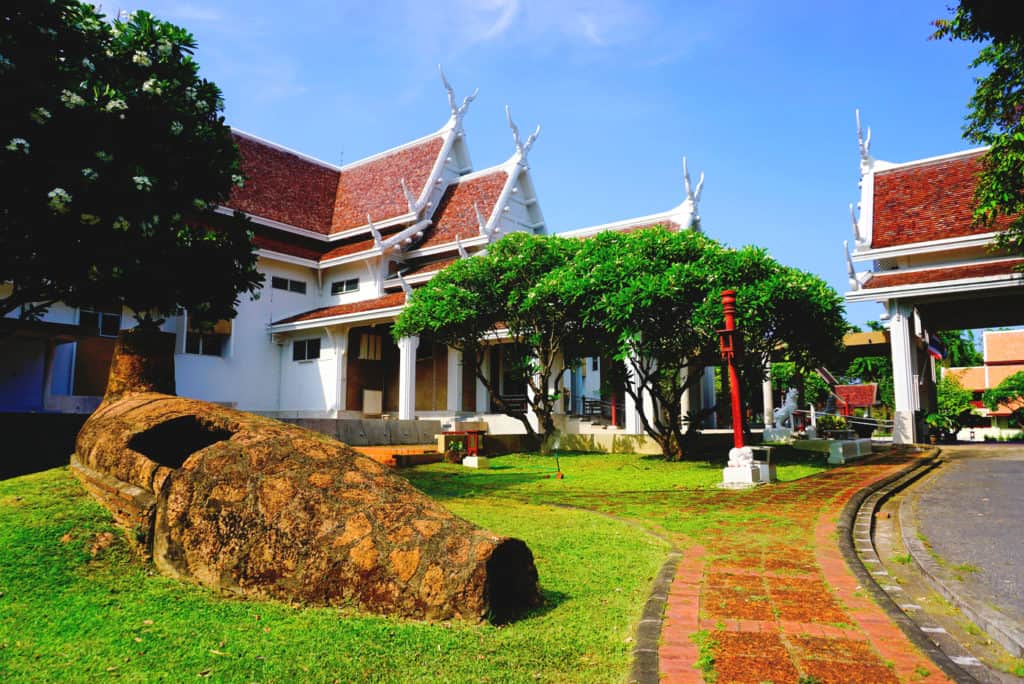
Experience the Chiang Mai National Museum
As the most prominent museum in northern Thailand, the Chiang Mai National Museum is at the forefront of local history. In 1996, the museum underwent a significant renovation as a part of Chiang Mai 700 year celebration. Now, locals and travelers alike can access exceptional exhibitions that explore the lengthy past of the city, from its beginning to the modern day.
The National Museum is split into six sections. Each represents a chronological experience with the last divulging the future plans and hopes of not just Chiang Mai but the northern regions. Highlights include an elaboration on the cultural background of the city, including the historical figures that laid its foundations and its position as the capital of the Lanna Kingdom. An aspect that has led to many locals considering themselves Lanna first and Thai second. You can also learn all about the geography and ecosystems that are found in Northern Thailand.
The Chiang Mai National Museum can be found alongside Wat Jed Yod.
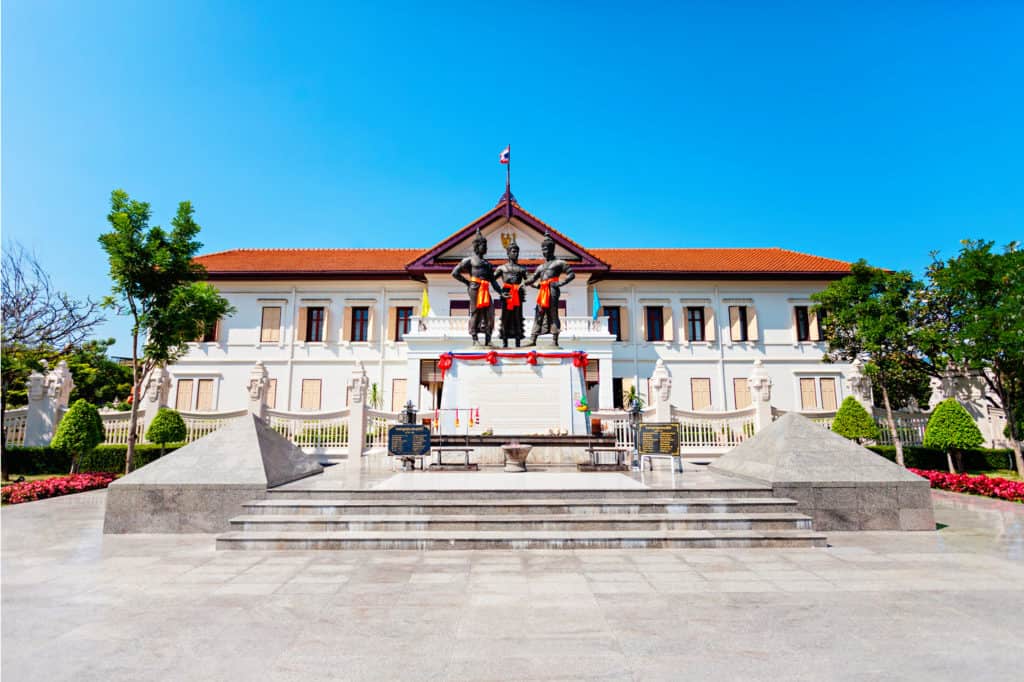
Explore the Chiang Mai City Arts and Cultural Centre
In one of the top examples of post-colonial architecture in Thailand, the City Arts and Cultural Centre invites you to learn more about the Lanna Kingdom. Sharing some similarities to the National Museum, you can peruse artifacts and multimedia exhibits to learn about the first settlers in the region.
The centre is within an old parliamentary building that opened in the 1920s. The building was repurposed in order to preserve the ancient culture and make it more accessible for visitors. A major highlight of the experience is the replica of a traditional wooden village.
You can purchase a combination ticket that allows you access not just to this attraction, but also the Lanna Folk Life Museum and the Historical Centre.

Enjoy a Festival
Chiang Mai has a packed calendar of festivals and events. It’s likely you’ll be around when something is being celebrated. However, if you arrive in the days after any of these festivals, it may be worth slightly changing your Thailand itinerary.
In November, a duo of lantern festivals take place, creating an utterly sparkling skyline, complemented by a spectacle of fun on solid ground. The two festivals are Loy Krathong and Yi Peng. Loy Krathong is a magical event that celebrates the Goddess of Water and the end of the rainy season. Locals gather along any body of water, from lakes to canals, and release candle-laden rafts and krathongs (lanterns) into the sky.
In February, Chiang Mai celebrates their annual Flower Festival. The city is known as the “Rose of the North”, so it’s only natural that it would have such a vibrant flora celebration. Street markets are set up and there’s ample live music, both of which complement the dazzling display of flowers and exciting parades.
However, the king of all Chiang Mai festivals is Songkran. While you can celebrate this unique but enthralling festival all over Thailand, Chiang Mai is the perfect spot. Songkran celebrates the Thai New Year each April, lasting several exhilarating and exhausting days. During this time, no one is exempt from getting wet in what is essentially an organized water fight. With each splash representing a blessing.
The moat that surrounds the Old City turns into a popular gathering spot to load up the buckets before soaking anyone that passes by.
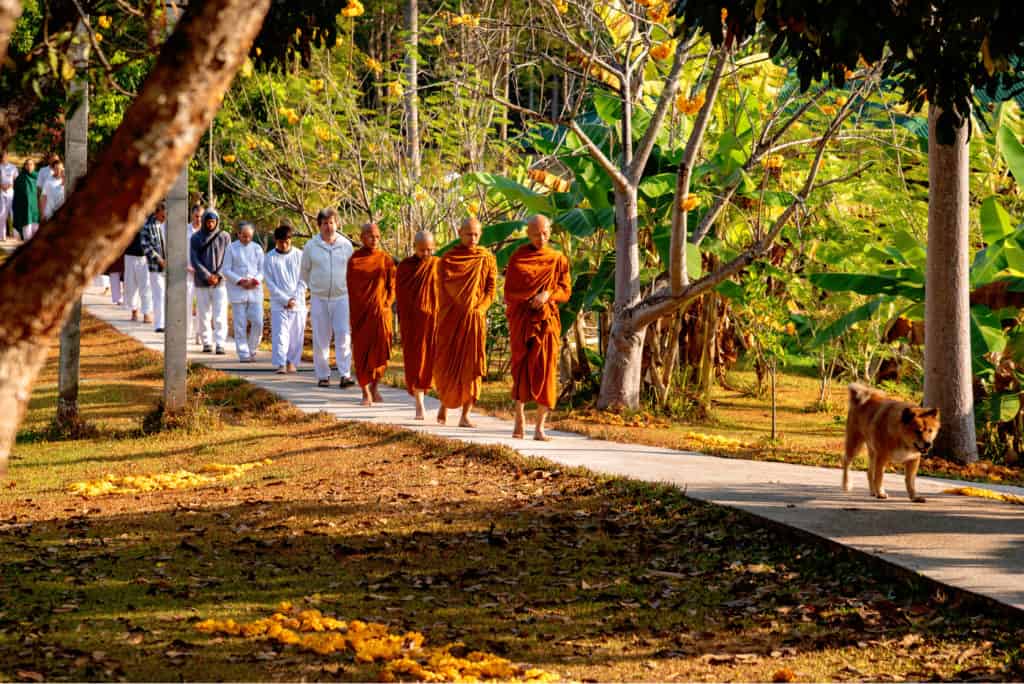
Go and Meditate. No: Really Meditate
Wat Phra That Doi Suthep isn’t just a temple to explore and admire, it’s also a place of meditation where you can leave the world behind. Take a journey into your soul by signing up for a retreat at Doi Suthep Vipassana Meditation Centre.
The temple may receive hundreds of visitors a day, but you can easily escape the noise with a series of specific meditation classes alongside the temple’s monks. The courses here run from 3 to 28 days — most go for 10 days — so you’ll want to have some space on the itinerary. But as one of the most revered meditative retreats in Thailand, many would say that it’s worth every second.
Like the ashrams of India, there’s no talking at Vipassana Meditation Centre. Your time spent here will be all about lightening your mind and controlling your breathing.
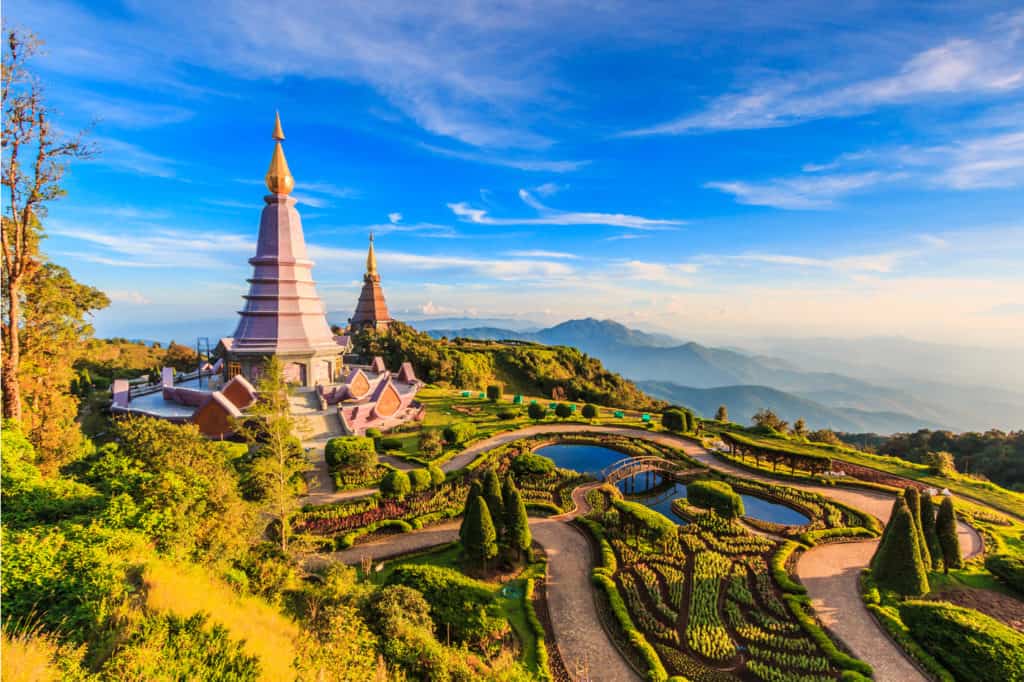
Go Hiking in Doi Inthanon National Park
One of the best side trips from Chiang Mai is an expansive national park that requires multiple days to see it all. Not far from Doi Pu Village, combine the two for an unforgettable time in the Danen Mountain Range.
Otherwise known as the “Roof of Thailand” Doi Inthanon is the tallest peak in Thailand, standing at 8,415 feet (2,564m) abode sea level. For those willing to brave the sunny skies, you’ll have two choices when hiking to the top of Thailand. The first is the short and sweet Ang Ka Luang Trail, that starts very close to the peak. Or the longer 2.1 mile Kew Mae Pan Trail that leads through wildflower forests on your way to the summit. You’ll also enjoy the opportunity to have a guide from the Hmong Tribe.
The Doi Inthanon National Park is also home to several waterfalls and rice terraces to explore. Along with embellished gardens and beautiful pagodas, each with enthralling views.
Explore the national park with an expert guide on this small group tour.
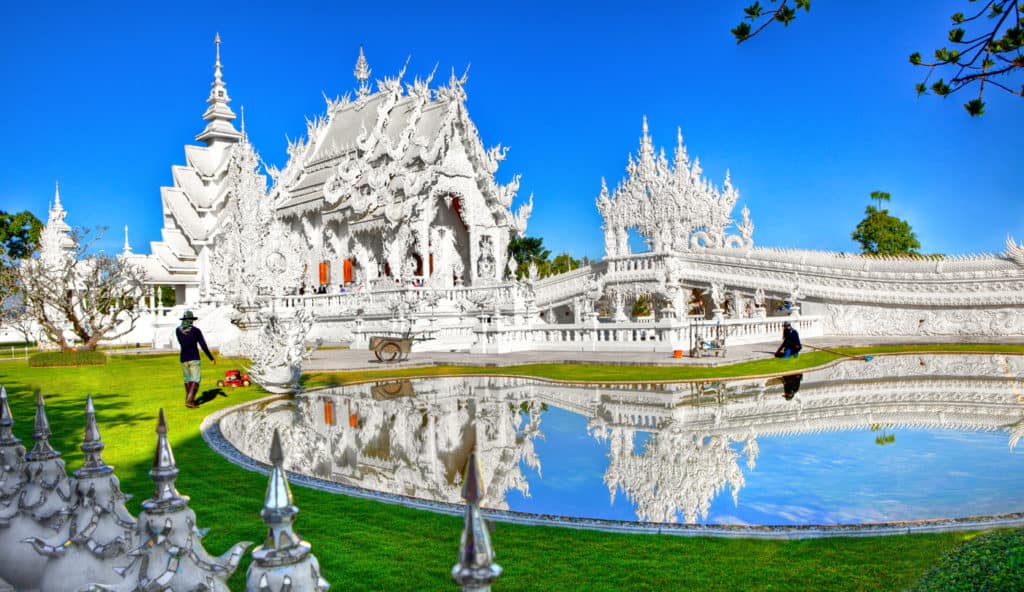
Take a Trip to Chiang Rai
Three hours northeast of Chiang Mai is Chiang Rai. Established under the reign of King Mangrai in the 13th century. It’s the most northern major city in all of Thailand, with its many rivers and tributaries rolling into the famous Mekong River. Despite its relatively large population, Chiang Rai enjoys a rural feel with few tourists, many historical attractions and mouthwatering cuisine.
Chiang Rai requires multiple days to see it all, so those on a day trip will have an exciting yet packed itinerary. Some of the top sights to see in town, includes the Golden Clock Tower, which stands in the center of the busy roundabout. At night, it shines like the sun against the backdrop of the black sky.
Have your pick of multiple ornate temples, including Wat Rong Sear Tean (the Blue Temple) and Wat Huai Pla Kung. The latter of which features a giant white Buddha that looks over the city.
Tick off the Golden Triangle (where Myanmar, Laos, and Thailand meet) on your day trip to Chiang Rai.
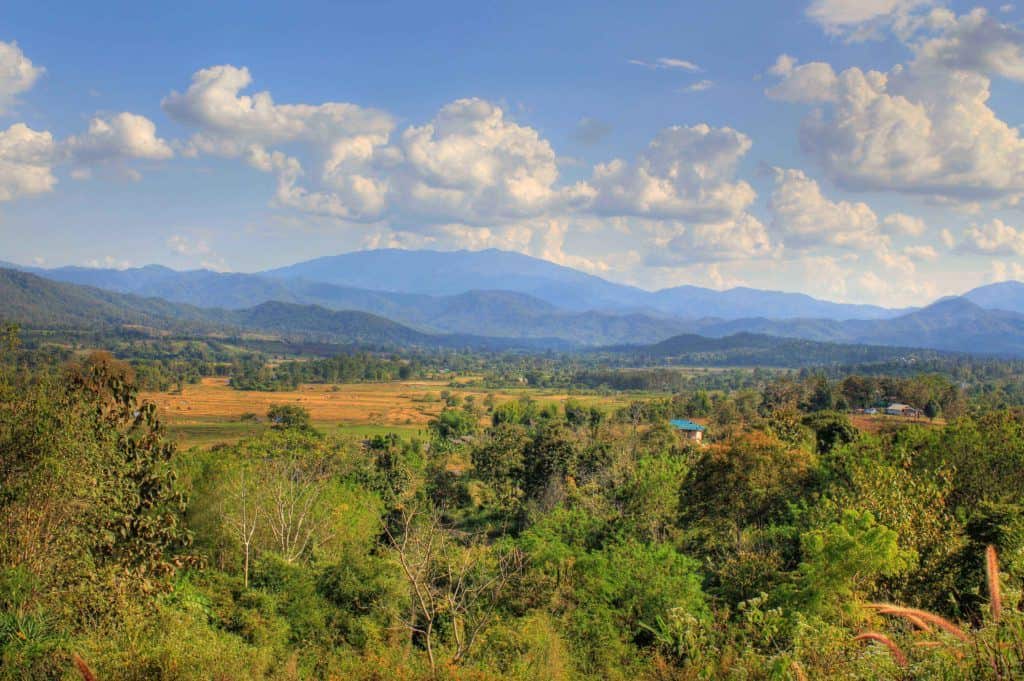
Ride the Mae Hong Son Loop
While in Chiang Mai, you should take the time to explore the lush flowing mountains where you’ll find alpine villages, tribal communities and the gorgeous city of Pai. Riding a scooter in Thailand is a quintessential traveling experience. While Bangkok will be hectic for even the most veteran rider, Chiang Mai presents a more calm experience. If only by a bit.
Once out of the city, with the wind surging by your shoulders, you’ll feel an immense sense of freedom. Away from fellow adventurers, you’ll feel you’re writing your own page, in places that are unique, untouched, and unspoiled.
The roads head up to vast peaks, bringing you through the morning mist to majestic views. Lunch is had in small markets where ingenuity and improvisation are often needed to order. You’ll pass waterfalls for spontaneous showers and regular detours, tempting you further off the beaten path.
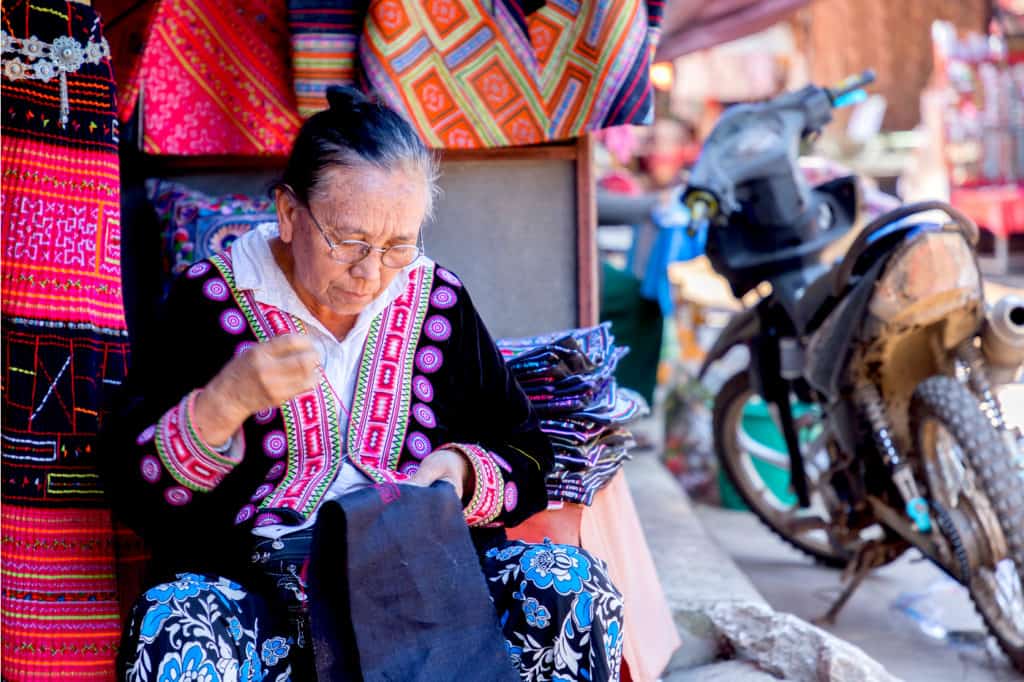
Learn about the mountain tribes at Doi Pui Village
Along your motorcycle adventure, you’ll cross path with traditional mountain tribes. When well dressed and respectful, you’ll find them to be welcoming of spontaneous guests, the ones who didn’t seek them out. It’s a unique and memorable experience. However, one of the best ways to visit and learn about the tribes just out of Chiang Mai is to visit Doi Poi.
The village is geared towards travelers, making it a simple introduction to the history of the community that has lived in the mountains for hundreds of years. Wander through the village and authentic tribal homes before admiring the stunning views from the ornate garden.
Just below the village, you’ll find several small cafes surrounded by lush greenery. Stop by to order the most famous dish in Chiang Mai, khao soi, a spiced coconut soup with thick and crunchy noodles.
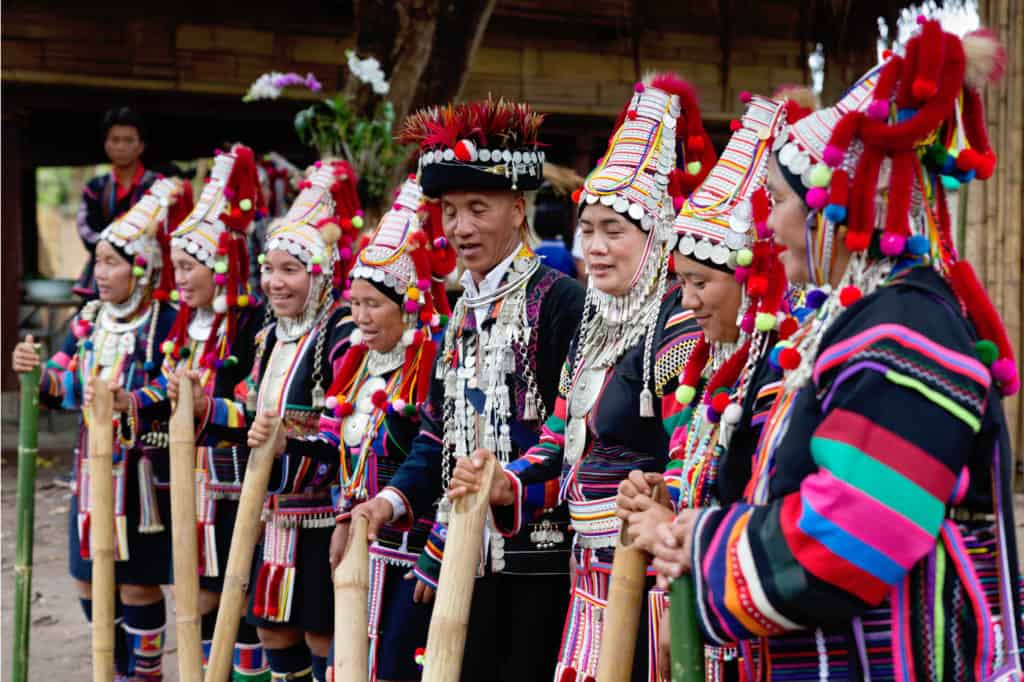
Visit the Highland People Discovery Museum
After your time spend in the hills, you’ll be eager to learn more about Thailand’s hill tribes. You can do just that here at the Highland People Discovery Museum. There are two large hill tribes in Northern Thailand, the Hmong and Karen, but there are also a number of smaller tribes to discover.
Also known as the Chiang Mai Tribal Museum, the many exhibits and displays dive into the culture, traditions and heritage of the mountain communities. Learn about various clothing, jewelry, and the intricate differences between each tribe. The latter is explored through a series of multimedia exhibits all showcasing the many tribes’ delicate relationships with the rest of Thailand.
The Highland People Discovery Museum plays a prominent role in preserving the history of the tribes, especially as they have no written language. After seeing all the inside displays, head to the exterior section where you’ll find replicas of tribal huts and a gift shop featuring crafts from community members.

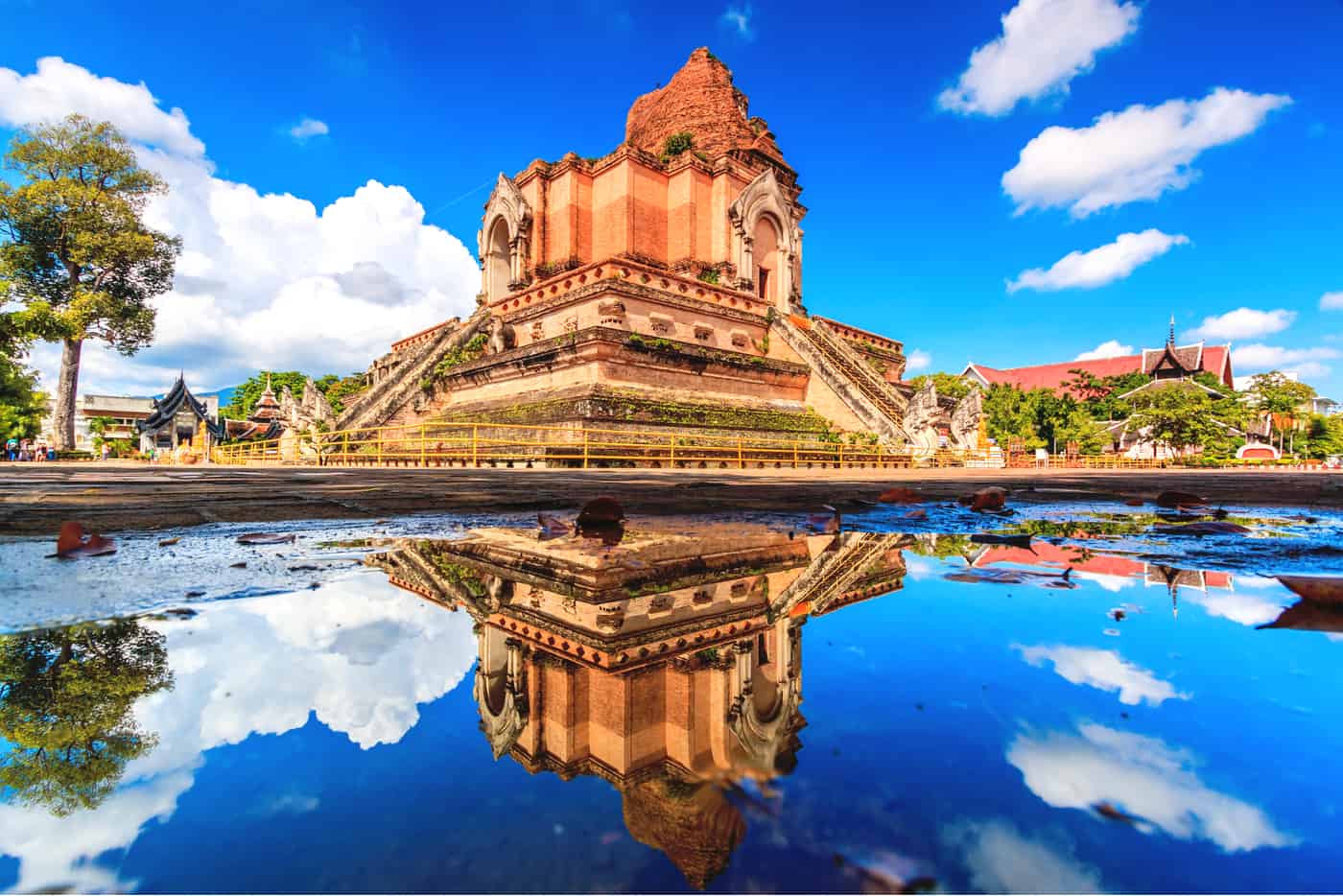





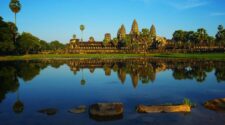
No Comment